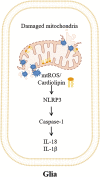Mitochondrial-derived damage-associated molecular patterns amplify neuroinflammation in neurodegenerative diseases
- PMID: 35233090
- PMCID: PMC9525705
- DOI: 10.1038/s41401-022-00879-6
Mitochondrial-derived damage-associated molecular patterns amplify neuroinflammation in neurodegenerative diseases
Abstract
Both mitochondrial dysfunction and neuroinflammation are implicated in neurodegeneration and neurodegenerative diseases. Accumulating evidence shows multiple links between mitochondrial dysfunction and neuroinflammation. Mitochondrial-derived damage-associated molecular patterns (DAMPs) are recognized by immune receptors of microglia and aggravate neuroinflammation. On the other hand, inflammatory factors released by activated glial cells trigger an intracellular cascade, which regulates mitochondrial metabolism and function. The crosstalk between mitochondrial dysfunction and neuroinflammatory activation is a complex and dynamic process. There is strong evidence that mitochondrial dysfunction precedes neuroinflammation during the progression of diseases. Thus, an in-depth understanding of the specific molecular mechanisms associated with mitochondrial dysfunction and the progression of neuroinflammation in neurodegenerative diseases may contribute to the identification of new targets for the treatment of diseases. In this review, we describe in detail the DAMPs that induce or aggravate neuroinflammation in neurodegenerative diseases including mtDNA, mitochondrial unfolded protein response (mtUPR), mitochondrial reactive oxygen species (mtROS), adenosine triphosphate (ATP), transcription factor A mitochondria (TFAM), cardiolipin, cytochrome c, mitochondrial Ca2+ and iron.
Keywords: microglia; mitochondrial dysfunction; mitochondrial-derived damage-associated molecular pattern; neurodegenerative diseases; neuroinflammation.
© 2022. The Author(s).
Conflict of interest statement
The authors declare no competing interests.
Figures






Similar articles
-
Mitochondrial DAMPs: Key mediators in neuroinflammation and neurodegenerative disease pathogenesis.Neuropharmacology. 2025 Feb 15;264:110217. doi: 10.1016/j.neuropharm.2024.110217. Epub 2024 Nov 16. Neuropharmacology. 2025. PMID: 39557152 Review.
-
The Role of Mitochondrial Damage-Associated Molecular Patterns in Chronic Neuroinflammation.Mediators Inflamm. 2019 Apr 1;2019:4050796. doi: 10.1155/2019/4050796. eCollection 2019. Mediators Inflamm. 2019. PMID: 31065234 Free PMC article. Review.
-
Mitochondrial Damage-Associated Molecular Patterns Content in Extracellular Vesicles Promotes Early Inflammation in Neurodegenerative Disorders.Cells. 2022 Aug 1;11(15):2364. doi: 10.3390/cells11152364. Cells. 2022. PMID: 35954208 Free PMC article. Review.
-
Mitochondrial quality control and transfer communication in neurological disorders and neuroinflammation.Front Immunol. 2025 Apr 28;16:1542369. doi: 10.3389/fimmu.2025.1542369. eCollection 2025. Front Immunol. 2025. PMID: 40356918 Free PMC article. Review.
-
Mitochondrial DNA Leakage and cGas/STING Pathway in Microglia: Crosstalk Between Neuroinflammation and Neurodegeneration.Neuroscience. 2024 Jun 7;548:1-8. doi: 10.1016/j.neuroscience.2024.04.009. Epub 2024 Apr 27. Neuroscience. 2024. PMID: 38685462 Review.
Cited by
-
Mitochondrial dysfunction as a possible trigger of neuroinflammation at post-traumatic stress disorder (PTSD).Front Physiol. 2023 Oct 24;14:1222826. doi: 10.3389/fphys.2023.1222826. eCollection 2023. Front Physiol. 2023. PMID: 37942228 Free PMC article. Review.
-
Transcranial photobiomodulation for reducing symptoms of autism spectrum disorder and modulating brain electrophysiology in children aged 2-7: an open label study.Front Child Adolesc Psychiatry. 2025 Jan 29;4:1477839. doi: 10.3389/frcha.2025.1477839. eCollection 2025. Front Child Adolesc Psychiatry. 2025. PMID: 39944746 Free PMC article.
-
Targeting the Electron Transport System for Enhanced Longevity.Biomolecules. 2025 Apr 23;15(5):614. doi: 10.3390/biom15050614. Biomolecules. 2025. PMID: 40427507 Free PMC article. Review.
-
Targeting PBK with small-molecule 1-O-acetyl-4R,6S-britannilactone for the treatment of neuroinflammation.Proc Natl Acad Sci U S A. 2025 Jul 22;122(29):e2502593122. doi: 10.1073/pnas.2502593122. Epub 2025 Jul 14. Proc Natl Acad Sci U S A. 2025. PMID: 40658838
-
Mitochondria as mediators of systemic inflammation and organ cross talk in acute kidney injury.Am J Physiol Renal Physiol. 2022 Jun 1;322(6):F589-F596. doi: 10.1152/ajprenal.00372.2021. Epub 2022 Apr 4. Am J Physiol Renal Physiol. 2022. PMID: 35379000 Free PMC article. Review.
References
Publication types
MeSH terms
Substances
LinkOut - more resources
Full Text Sources
Miscellaneous

